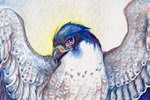I have started work on my M.F.A. Illustration thesis - a bit early actually, but with the amount of research and artwork that are required for such a massive project, it is necessary. The subject of my thesis will be an illustrative look at birds of prey and their influence on human life, history, and culture. In addition, I will look at the place of raptor artists such as John James Audubon, Roger Tory Peterson, Roger Bateman, and Peter Parnall and explore how their work affected peoples' perception of birds of prey.
Subjects I will look at include golden eagles as used by the Mongolian eagle hunters, falconry in the Middle East, Europe, and North America, owls and hawks as natural 'rodent control' on farms, and the place of birds of prey as deities, such as the harpy eagle in South America, the bald and golden eagles by Native Americans, and the vulture and falcon in ancient Egypt.
I have completed the first painting of 15, which depicts the golden eagle of the Mongolian eagle hunters. As I will be showing these for my thesis exhibition, I have chosen not to publish them online until after my exhibition. However, I will continuously be uploading the sketches and works in progress here as I complete them.
The second painting I am working on depicts the barn owl. A nice quote I found concerning the hunting skill of this intriguing bird is summed up quite well by Ted Andrews in his book,
Animal Speak: "
A barn owl can kill ten times the amount of mice than a cat in a single night and more if there are young to be fed.” This fact has been reiterated in a number of texts, including Iain Taylor's
"Barn Owls: Predator-Prey Relationships and Conservation and Angus Cameron and Peter Parnall's
The Nightwatchers. The fact that barn owls are simply excellent at hunting mice seems pervasive. Unfortunately, this knowledge wasn't always so widespread. Owls, as well as many buteos have historically been shot, trapped, and poisoned by farmers who incorrectly believe them to be poultry hunters. The ironic truth is that without these birds to control rodent populations, many a farmer finds his crops overrun by mice, voles, and other small mammals.
Here is one page of rough sketches:

For my final painting, I combined aspects of the bottom two. I liked the almost-profile view of the owl in flight, but I also wanted an owl perched, in the bottom left corner. I also found several problems with light sources (such as the moon behind the owl, which is illuminated from the other side), which I fixed in the final sketch.
This is the final drawing on the stretched watercolor paper (about 10.5 X 17 inches). I have purposefully left the owls undetailed, as I will be masking them with masking fluid to keep their edges crisp and white for when I do the first, broad washes for the background.

I have developed a fondness for barn owls after doing all this research on them. Their lifespans are strangely short for a bird of prey (under 8 years for most - owls in general usually live at least 10 to 15 years, and many hawks and eagles live up to 30 years in the wild). Paired with their almost ethereal appearance and presence, they seem almost otherworldly. Spiritual. Every time I look at the gray, white, and brown plumage of a barn owl, I cannot help but think of how these birds have such a natural aesthetic! I look forward to painting this one.













